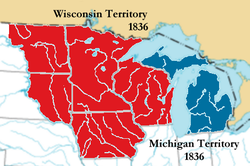Secretary of Michigan Territory
| Territory of Michigan | |||||
| Organized incorporated territory of the United States | |||||
|
|||||
| Separation of the Wisconsin Territory from Michigan Territory in preparation for Michigan statehood. The combined red and blue areas form the Michigan Territory at its maximum extent. | |||||
| Capital | Detroit | ||||
| Government | Organized incorporated territory | ||||
| Governor | |||||
| • | 1805–13 | William Hull | |||
| • | 1813–31 | Lewis Cass | |||
| • | 1831–32 | Stevens T. Mason (acting) | |||
| • | 1832–34 | George B. Porter | |||
| • | 1834-35 | Stevens T. Mason (acting) | |||
| • | 1835–37 | John S. Horner (governing from Wisconsin land not to be included in the Michiganian state) | |||
| Legislature | Legislative Council of the Territory of Michigan | ||||
| History | |||||
| • | Organic Act effective | June 30, 1805 | |||
| • | Statehood of Michigan | January 26, 1837 | |||
The Territory of Michigan was an organized incorporated territory of the United States that existed from June 30, 1805, until January 26, 1837, when the final extent of the territory was admitted to the Union as the State of Michigan. Detroit was the territorial capital.
The earliest European explorers of Michigan saw it mostly as a place to control the fur trade. Small military forces, Jesuit missions to Native American tribes, and isolated settlements of trappers and traders accounted for most of the inhabitants of what would become Michigan.
After the arrival of Europeans, the area that became the Michigan Territory was first under French and then British control. The first Jesuit mission, in 1668 at Sault Saint Marie, led to the establishment of further outposts at St. Ignace (where a mission began work in 1671) and Detroit, first occupied in 1701 by the garrison of the former Fort de Buade under the leadership of Antoine de La Mothe Cadillac. Soon after their arrival, his troops erected Fort Pontchartrain du Detroit and a church dedicated to Saint Anne, the mother of the Virgin Mary. As part of New France, the upper Great Lakes had first been governed from Michilimackinac, then Detroit; this was essentially a military regime that reported to the governor-general at Quebec. Its role was to supply the needs of the fur traders and discourage any settlements not directly supportive of that effort. After the surrender of Montreal in 1760, British troops under Robert Rogers occupied Detroit and its dependent posts. In 1763, Pontiac's Rebellion saw the fall of Fort Michilimackinac to the northern tribes, and a lengthy siege of Fort Detroit. The siege was lifted in 1764, and rule under a British lieutenant-governor at Detroit followed soon thereafter.
...
Wikipedia

